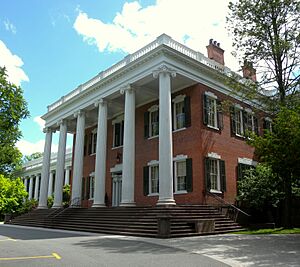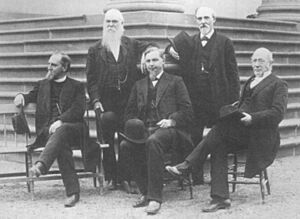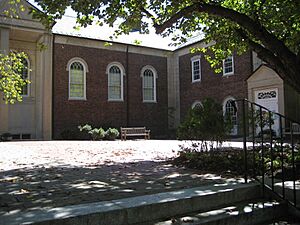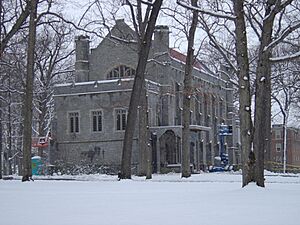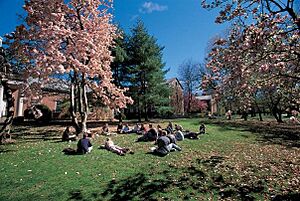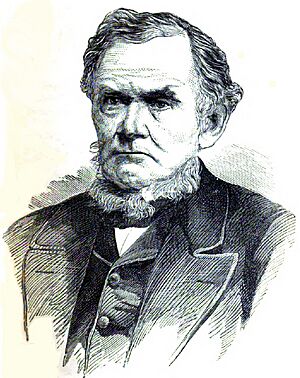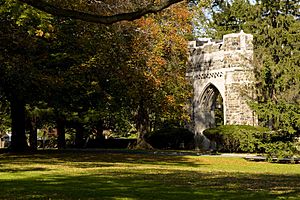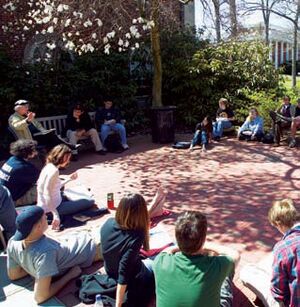Drew University facts for kids
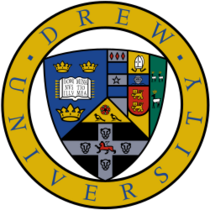 |
|
|
Former names
|
Drew Theological Seminary (1867–1928) |
|---|---|
| Motto |
δωρεὰν ἐλάβετε, δωρεὰν δότε
|
|
Motto in English
|
"Freely ye have received, freely give." (from Matthew 10:8 KJV) |
| Type | Private university |
| Established | 1867 |
|
Religious affiliation
|
United Methodist Church |
| Endowment | $183.1 million (2019) |
| President | Hilary L. Link |
|
Academic staff
|
244 |
|
Administrative staff
|
345 |
| Students | 2,113 |
| Undergraduates | 1,636 (Fall 2020) |
| Postgraduates | 696 |
| Location |
,
U.S.
|
| Campus | 186 acres (0.75 km2) wooded, Suburban |
| Colors | Blue and green |
| Nickname | Rangers |
|
Sporting affiliations
|
NCAA Division III, ECAC, Landmark Conference, IHSA |
Drew University is a private university located in Madison, New Jersey. It has a beautiful campus with lots of trees, covering about 186 acres. In the fall of 2020, more than 2,200 students were studying at Drew in its three main schools.
The university started in 1867 when a wealthy businessman named Daniel Drew bought a large estate in Madison. He wanted to create a theological seminary, which is a school to train people to become ministers in the Methodist Church. Later, the school grew. In 1928, it added a program for undergraduate students to study a wide range of subjects, known as a liberal arts college. Then, in 1955, it started offering programs for students who wanted to continue their education after their first degree.
Today, the College of Liberal Arts has over 1,600 undergraduate students. They can study subjects like science, social studies, languages, arts, and more. The Drew Theological School is one of the oldest Methodist seminaries and currently has over 350 students. The Caspersen School of Graduate Studies has over 250 students working on advanced degrees. Even though Drew University is connected to the Methodist faith, it welcomes students of all backgrounds and does not require them to follow any specific religion.
Contents
History of Drew University
From a Big Estate to a School (1832–1928)
In 1866, Daniel Drew, a rich businessman who made his money in railroads, offered to build and support a school for Methodist ministers near New York City. He asked that his pastor, John McClintock, lead the new school. Classes began in 1867, with McClintock as the first president. Drew University is one of the oldest Methodist schools for ministers.
The school taught students how to become ministers but also offered them a chance to learn about many other subjects. Famous professors taught there, like James Strong. He created Strong's Concordance, a very helpful book for studying the Bible.
Becoming a Liberal Arts College (1928–1990)
For many years, Drew Theological Seminary trained hundreds of Methodist ministers. In 1920, it started a program for women, which was a big step.
In 1928, two brothers, Arthur J. Baldwin and Leonard D. Baldwin, gave $1.5 million to the school. They were successful lawyers who wanted to create an undergraduate college where students could study many different subjects. They asked for the new college to be named "Brothers College" to honor their close bond. Because of this new college, the seminary changed its name to "Drew University" to show it was growing.
Brothers College, which later became the College of Liberal Arts, opened in September 1928 with just 12 students. During World War II in 1942, the college started accepting both men and women. This happened because many male students were joining the military. Drew also helped U.S. Navy personnel get an education to become officers.
Drew started offering advanced degrees in 1912. In 1955, it created the Graduate School for students who wanted to study beyond their first degree. This school was later renamed the "Caspersen School of Graduate Studies" after a generous donation from Finn M. W. Caspersen and his wife Barbara.
In the 1970s, Drew started a special program for first-year students called a "freshman seminar." This allowed new students to study a topic they were interested in with their professors. Drew also began offering new subjects like neuroscience and American studies.
In 1984, Drew was the first liberal arts college to give a personal computer to every new student. This program, called the "Computer Initiative," helped Drew stand out until 2012, when most students already had their own computers.
Drew University Today (1990–Present)
After being the governor of New Jersey, Thomas Kean became Drew's president in 1990 and served for 15 years. During his time, he helped the university raise a lot of money, added new teachers, and created more chances for students to study abroad. He also oversaw over $60 million in new buildings and renovations.
In 2015, William Campbell, a researcher at Drew University, won the Nobel Prize in Physiology or Medicine. He was honored for his work in developing a medicine that treats diseases caused by parasites.
In 2017, Drew University announced it was lowering its tuition price by 20%. This was done to make the school more affordable and attractive to new students. In 2023, Hilary L. Link became the fifteenth president of Drew University.
Drew University Campus
Drew University is in Madison, New Jersey, which is about 25 miles west of New York City. Madison is known as "the Rose City" because it used to have many rose farms. It's a quiet town where many people live and travel to work in bigger cities. The university is also home to the Shakespeare Theatre of New Jersey, a professional theater company.
The university campus used to be the estate of William Gibbons, who owned a steamboat business. He bought the land in Madison in 1832 and called his property "The Forest." This is why Drew University is sometimes called the "University in the Forest."
In 1867, Daniel Drew bought Gibbons' estate and gave it to the church to start the Methodist theological seminary. The main mansion on the estate was renamed "Mead Hall" in honor of Drew's wife.
Drew's buildings have different styles, including old Greek-style buildings and castle-like designs. The campus is a peaceful, wooded area in the middle of a busy town. It includes the Drew Forest Preserve, an 80-acre forest that has been restored with new trees and plants. The campus also has the Florence and Robert Zuck Arboretum, which is like a living museum of trees and plants. It has two small ponds with turtles, fish, and birds.
Both the forest preserve and the arboretum are used by students for studying biology and science. They are also open to the public by appointment. These natural areas are important for keeping the local water clean.
Academics at Drew
How to Get In
In 2024, Drew University accepted about 73% of students who applied. Students who were accepted usually had an average GPA (grade point average) of 3.1. Drew University is a "test optional" school, which means you don't always have to send your SAT or ACT scores to apply.
What Others Say About Drew
For 2024, U.S. News & World Report ranked Drew University among the top 100 National Liberal Arts Colleges. It was also ranked highly for helping students from all backgrounds succeed.
Official Recognition
Drew University is officially recognized by the Middle States Commission on Higher Education. This means that the education you get at Drew meets high quality standards. The theological school and other programs are also approved by other important organizations, including the United Methodist Church.
What You Can Study as an Undergraduate
Drew University offers programs for students to earn a Bachelor of Arts or Bachelor of Science degree. Students take a variety of core courses, but they also get to choose many classes to create their own unique study plan. Drew focuses on helping students do deep research, learn by doing, and work together in teams. Students must also choose a minor, which is a secondary area of study. Drew offers majors in 50 different subjects and 20 minor subjects. Princeton Review has often said that Drew has one of the top 20 theater programs in the U.S.
Here are some of the most popular subjects students studied in 2021:
- Business Administration and Management
- Psychology
- Biology
- Communication and Media Studies
- Economics
- Fine/Studio Arts
- Computer Science
Drew also has some special programs for undergraduate students:
- Semester on Wall Street: Students go to New York City twice a week to learn about finance and meet people who work in banks and financial companies.
- Semester on the United Nations: Students attend classes near the UN Headquarters in New York City. They learn about global issues and attend meetings.
- Research Institute for Scientists Emeriti (RISE): Students work on research projects with retired scientists.
- Drew Summer Science Institute: Students work full-time on a science research project with a professor during the summer.
- New York Semester on Contemporary Art: Students visit art museums in New York City and discuss modern art.
- London Semester: Students travel to London to learn about political and social changes in Great Britain.
Advanced Studies (Graduate Programs)
Drew University has offered advanced studies since 1912. The Caspersen School of Graduate Studies offers master's and doctoral degrees in many specialized subjects. This is where students go if they want to continue learning after their first college degree.
Programs for Ministry (Theological School)
The Drew Theological School started in 1867. It trains people to become ministers in the United Methodist Church and other Christian faiths. In 1920, women were first allowed to study there. One notable graduate, Olive Winchester, became the first female ordained minister in Great Britain in 1925.
The school has strong ties to Korean Methodism. Henry Appenzeller, a graduate from 1885, was the first Christian missionary to Korea. He helped start the Korean Methodist Church and translated the Bible into Korean. Because of his work, many students from South Korea still come to study at Drew today.
The Theological School offers several different degree programs. In 2018, it started the "Drew Social Justice Leadership Project" to help students and professors share their ideas about important social issues.
Rose Memorial Library and Methodist Archives
The Rose Memorial Library is home to Drew University's large collection of books, journals, and other materials. It has over 558,000 books and many electronic resources. The library also has special collections, including rare books from the 11th century.
Drew University also keeps the United Methodist Archives and History Center. This is one of the biggest collections of Methodist books and items in the world. It helps people learn about the history of the Methodist Church in England and America.
The library's special collections also include many books and papers from the famous American author Willa Cather. This is considered one of the best collections of her work in the United States.
Sports at Drew
Drew University's sports teams are called the Rangers. They used to be known as "The Circuit Riders" because of their Methodist history. The Rangers compete in NCAA Division III, which is a level for college sports. Drew has 20 teams for men and women in 12 different sports.
The Rangers are part of the Landmark Conference for many sports like basketball, soccer, tennis, and baseball. They also have fencing and equestrian (horse riding) teams that compete in other leagues. Drew offers many club teams, like ultimate frisbee and rugby, and also has fun intramural sports programs for students to play for enjoyment.
| Sport | Men or Women |
|---|---|
| Baseball | Men |
| Basketball | Both |
| Cross Country | Both |
| Equestrian | Women |
| Fencing | Both |
| Field Hockey | Women |
| Golf | Both |
| Lacrosse | Both |
| Soccer | Both |
| Softball | Women |
| Track and Field | Both |
| Tennis | Both |
| Volleyball (2022) | Both |
Famous People from Drew University
Many people who have studied or taught at Drew University have become well-known in different fields.
Some famous teachers include:
- James Strong, who created Strong's Concordance, a very important Bible study tool.
- William Campbell, who won the 2015 Nobel Prize in Physiology or Medicine for his work on medicines for parasitic diseases.
Some famous alumni (people who graduated from Drew) include:
- Henry G. Appenzeller, who was the first Methodist missionary to Korea and helped start the Korean Methodist Church.
- Olive Winchester, who was the first female ordained minister in Great Britain.
- John T. Cunningham, a popular historian and journalist.
- Jeff Smith, a minister, cookbook author, and host of the TV show The Frugal Gourmet.
- Peter Verniero, a former Attorney General and Supreme Court Justice in New Jersey.
See also
 In Spanish: Universidad Drew para niños
In Spanish: Universidad Drew para niños
- List of botanical gardens in the United States
- List of colleges and universities in New Jersey


